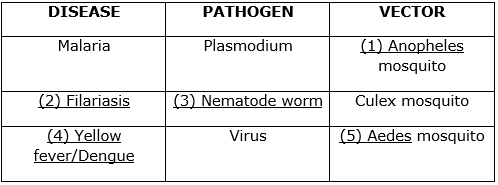Class 9 SELINA Solutions Biology Chapter 15 - Hygiene - A Key To Healthy Life
Hygiene - A Key To Healthy Life Exercise Ex. 1
Solution A.1(a)
(iv) cholera
Solution A.1(b)
(iv) Sharing towels with others
Solution A.1(c)
(iv) Plasmodium
Solution A.1(d)
(iii) fluorides
Solution A.1(e)
(ii) bacteria
Solution A.1(f)
(iv) contaminated water
Solution A.1(g)
(iii) Vector
Solution A.1(h)
(iii) DDT
Solution A.1(i)
(ii) Protozoan
Solution A.1(j)
(iv) Gambusia
Solution B.1
(a) Taking stimulants and sedatives are unhealthy habits.
(b) Physical exercise should be systematic and regular.
(c) Public drains and garbage must be covered with bleaching powder or lime.
(d) Housefly is often designated as public enemy no.1.
(e) Rat-flea is a parasite which lives on rat's skin.
Solution B.2
(a) Vibrio cholerae
(b) Domestic sewage
(c) Raticides
(d) Hepatitis
(e) Anthrax
Solution B.3

Solution C.1
(a) Health is the state or condition of the body of a person who depicts or portrays physical, mental, social and emotional fitness.
(b) Hygiene is defined as the science and practice of maintaining good health.
(c) A pathogen or germ is defined as a microorganism that causes or can cause a disease.
(d) Vector is an agent that acts as an intermediate carrier of a pathogen.
(e) Contamination means unwanted entry of disease-causing germs into drinking water or edible foods.
Solution C.2
(i) One should breathe by nose and never by mouth because nose contains hair and mucous to trap dust and micro-organisms, so that the inhaled air becomes pure and the respiratory passage is free of dust and micro-organisms.
(ii) We handle a variety of things like books, coins, furniture, tools and machinery in workshops, seats and supporting rods in buses and even pets and other domestic animals in our day-to-day life. Many of these objects carry germs. These germs can be picked up by us, when we touch these objects and get transferred to other parts of our body or into our mouth, when we eat our food. Therefore, it is necessary to wash our hands before eating food to avoid the spread of diseases caused due to these germs.
(iii) Flies are carriers of many disease-causing germs and bacteria. Therefore, eating places must be kept free of flies to avoid possible contamination of food.
Solution C.3
Cockroaches and rats are common household pests.
(i) Cockroaches are involved in spoiling food, paper and cloth. They may act as carriers of viruses, especially those which cause cancer.
(ii) Rats eat grains and other foods. They also act as carriers of certain pathogens. A parasite named rat-fleas lives on rat's skin. It possibly carries the germs of plague.
Solution C.4
|
TYPE OF DYSENTERY
|
CAUSATIVE GERM |
PRECAUTION
|
|
1. Bacillary dysentery |
Bacterium: Shigella dysenteriae |
Drinking safe (boiled) water |
|
2. Amoebic dysentery |
Protozoan: Entamoeba histolytica |
Avoiding contaminated water and food |
Solution C.5
Symptoms of Hepatitis:
• Body ache
• Yellow eyes
• Deep yellow urine
• Enlarged liver
Solution C.6
Two methods of controlling flies:
1. Spraying of insecticides
2. Elimination of breeding grounds
Solution C.7
Effective methods for controlling mosquitoes:
(i) Spraying insecticides
(ii) Food should be protected by covering it
(iii) Eliminating breeding places of mosquitoes
Solution C.8
Contamination of potable water can occur due to
• Improper disposal of sewage
• Defecation and urination near lakes, rivers or ponds
• Drainage of animal wastes and washings from dairies and poultries into water bodies
Solution D.1
The different ways by which the housefly contaminates our food:
(i) Hairy body and legs: Hairy or spiny body and legs easily pick up dirt containing germs from unhygienic places such as rotten materials, infected wound or faecal matter. When these flies sit on our food, they rub their legs continuously dropping the particles of dirt onto the food, thereby contaminating it.
(ii) Pouring out saliva: When the housefly pours its saliva or regurgitates on food, foodstuffs get moistened and pathogens get deposited on them. This results in their contamination.
(iii) Excreta: While feeding on food items, houseflies may deposit their excreta on food, contaminating it.
(iv) Direct transmission of germs: In some cases, houseflies directly transmit the pathogens. In case of eye disease trachoma, pathogens are transferred from an infected person to a healthy person, when a fly settled on an infected eye of a person sits on the eyes of a healthy person.
Solution D.2
Four major aspects of personal hygiene are cleanliness, rest and sleep, physical exercise, and healthy habits.
Solution E.1
(a) The organism is an amoeba. Its scientific name is Entamoeba histolytica.
(b) Yes, it is a causative agent of the disease called amoebic dysentery.
(c) 1 - Pseudopodium, 2 - Nucleus, 3 - Blood cell
(d) It is a unicellular organism. It belongs to category Protozoa.
(e) The pseudopodia extend from both sides of the food molecule, surround it, and eventually engulf it. As a result, pseudopodia are used in mobility as well as act as a tool to capture prey or gather necessary nourishment.

